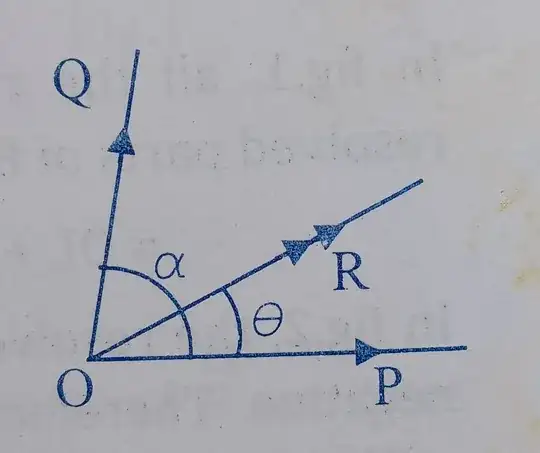Question:
Two forces $\vec{P}$ and $\vec{Q}$ acting at a point have a resultant $\vec{R}$ and the resolved part of $\vec{R}$ along $\vec{P}$ is equal to the magnitude of $\vec{Q}$. Prove that the angle between the forces is $\alpha=2\sin^{-1}\left(\sqrt{\frac{P}{2Q}}\right)$.
My book's attempt:
$$P+Q\cos\alpha=Q$$
$$P=Q(1-\cos\alpha)$$
$$\frac{P}{Q}=2\sin^2\frac{\alpha}{2}$$
$$\frac{P}{2Q}=\sin^2\frac{\alpha}{2}$$
$$\sqrt{\frac{P}{2Q}}=\sqrt{\sin^2\frac{\alpha}{2}}\tag{1}$$
$$\sqrt{\frac{P}{2Q}}=\sin\frac{\alpha}{2}\tag{2}$$
$$\sin\frac{\alpha}{2}=\sqrt{\frac{P}{2Q}}$$
$$\sin^{-1}(\sin\frac{\alpha}{2})=\sin^{-1}\left(\sqrt{\frac{P}{2Q}}\right)\tag{3}$$
$$\frac{\alpha}{2}=\sin^{-1}\left(\sqrt{\frac{P}{2Q}}\right)\tag{4}$$
$$\alpha=2\sin^{-1}\left(\sqrt{\frac{P}{2Q}}\right)$$
My comments:
They managed to prove what was given in the question, but their procedure is questionable in my opinion. Up to $(1)$, everything is correct, but in $(2)$, they did this $\sqrt{\sin^{2}\frac{\alpha}{2}}=\sin\frac{\alpha}{2}$. Shouldn't it have been $\sqrt{\sin^{2}\frac{\alpha}{2}}=|\sin\frac{\alpha}{2}|$? Also didn't they discard a lot of legitimate solutions in $(4)$ (related)?
My questions:
- Are lines $(2)$ and $(4)$ valid?
